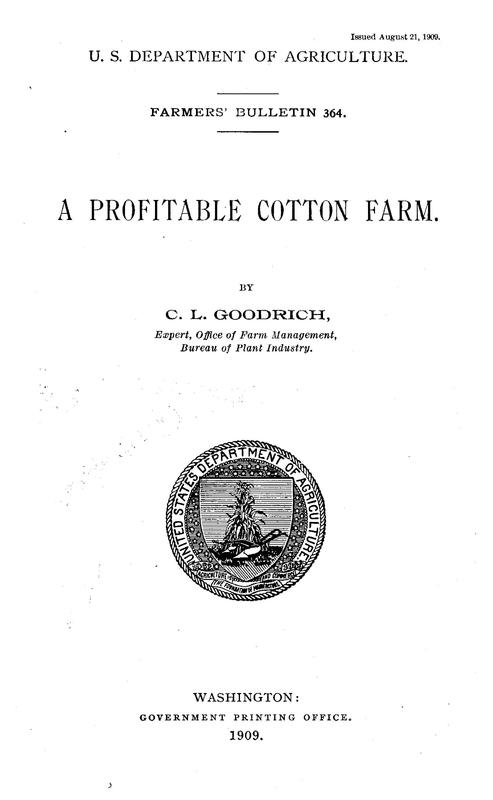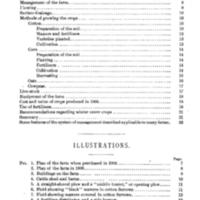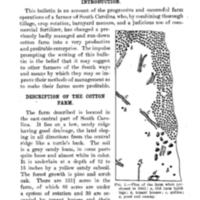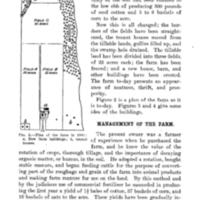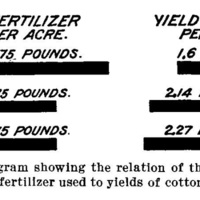A Profitable Cotton Farm
Creator
Date
1909
Excerpt
This bulletin is an account of the progressive and successful farm operations of a farmer of South Carolina who, by combining thorough tillage, crop rotation, barnyard manure, and a judicious use of commercial fertilizer, has changed a previously badly managed and run-down cotton farm into a very productive and profitable enterprise. The impulse prompting the writing of this bulletin is the belief that it may suggest to other farmers of the South ways and means by which they may so improve their methods of management as to make their farms more profitable.
DESCRIPTION OF THE COTTON FARM.
The farm described is located in the east-central part of South Carolina. It lies on a low, sandy ridge having good drainage, the land sloping in all directions from the central ridge like a turtle's back. The soil is a gray sandy loam, in some parts quite loose and almost white in color. It is underlain at a depth of 12 to 15 inches by a yellow sandy subsoil. The forest growth is pine and scrub oak. There are 131 3/4 acres in the farm, of which 66 acres are under a system of rotation and 30 are occupied by tenant houses and their surrounding lots. The remainder is woodland. The farm has been under cultivation some eighty years, and for the eight or ten years previous to the present ownership had been rented.
Figure 1 gives some idea of the condition of the farm when the present owner took possession in January, 1902. Several tenant houses were scattered promiscuously over it, a number of bad gullies had been allowed to develop, a swamp hole occupied part of one field, and clumps of scrubby trees, bushes, and broom sedge had grown up, making the fields irregular in shape and giving the farm a rough and unthrifty appearance. The fertility of the soil had been reduced to the low ebb of producing 300 pounds of seed cotton and 5 to 8 bushels of corn to the acre.
Now this is all changed; the borders of the fields have been straightened, the tenant houses moved from the tillable lands, gullies filled up, and the swamp hole drained. The tillable land has been divided into three fields, of 22 acres each; the farm has been fenced; and a new house, barn, and other buildings have been erected. The farm to-day presents an appearance of neatness, thrift, and prosperity.
DESCRIPTION OF THE COTTON FARM.
The farm described is located in the east-central part of South Carolina. It lies on a low, sandy ridge having good drainage, the land sloping in all directions from the central ridge like a turtle's back. The soil is a gray sandy loam, in some parts quite loose and almost white in color. It is underlain at a depth of 12 to 15 inches by a yellow sandy subsoil. The forest growth is pine and scrub oak. There are 131 3/4 acres in the farm, of which 66 acres are under a system of rotation and 30 are occupied by tenant houses and their surrounding lots. The remainder is woodland. The farm has been under cultivation some eighty years, and for the eight or ten years previous to the present ownership had been rented.
Figure 1 gives some idea of the condition of the farm when the present owner took possession in January, 1902. Several tenant houses were scattered promiscuously over it, a number of bad gullies had been allowed to develop, a swamp hole occupied part of one field, and clumps of scrubby trees, bushes, and broom sedge had grown up, making the fields irregular in shape and giving the farm a rough and unthrifty appearance. The fertility of the soil had been reduced to the low ebb of producing 300 pounds of seed cotton and 5 to 8 bushels of corn to the acre.
Now this is all changed; the borders of the fields have been straightened, the tenant houses moved from the tillable lands, gullies filled up, and the swamp hole drained. The tillable land has been divided into three fields, of 22 acres each; the farm has been fenced; and a new house, barn, and other buildings have been erected. The farm to-day presents an appearance of neatness, thrift, and prosperity.
Title
A Profitable Cotton Farm
File(s)
Profitable Cotton Farm Cover.jpg
(image/jpeg)
Profitable Cotton Farm TOC.jpg
(image/jpeg)
Profitable Cotton Farm 1.jpg
(image/jpeg)
Profitable Cotton Farm 2.jpg
(image/jpeg)
Profitable Cotton Farm 3.jpg
(image/jpeg)
 An official website of the United States government.
An official website of the United States government.


